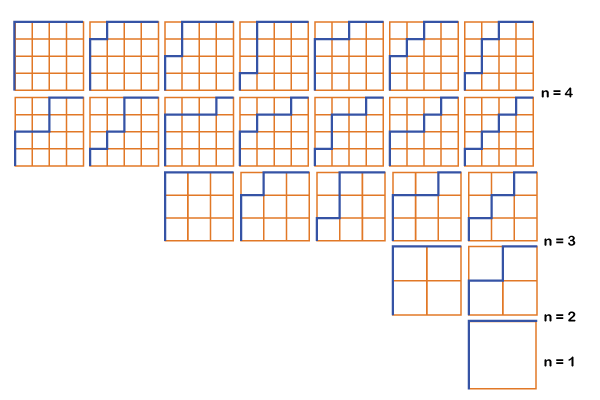Dyck Path in JavaIn Java programming, Dyck paths are a way to explore grids in a specific manner. Consider a square grid in which you wish to reach the top-right corner while keeping above a diagonal line. The idea is to see how many different pathways you may utilize to get there. Consider a n × n square grid with the top-left corner indexed as (0, 0). A Dyck path is a unique walk that begins in the bottom-left corner (n-1, 0) and ends in the top-right corner (0, n-1). The route must always stay above the diagonal line that runs from the grid's bottom left to the top right. The objective here is to determine and count the total number of Dyck Paths that match these conditions, namely those that connect points (n-1, 0) to (0, n-1). Example 1: Input: n = 1 Output: 1 Example 2: Input: n = 4 Output: 14 Example 3: Input: n = 6 Output: 132 Example 4: Input: n = 8 Output: 1430 
Approach: Using Catalan NumberThe approach to counting Dyck paths is based on the Catalan number formula: C_n = (2n)! / [(n + 1)! * n!] The formula represents the count of Dyck paths with a length of 2n, originating from the point (n-1, 0) and concluding at the point (0, n-1). Another way to express this is through the product: C_n = Π (n + k) / k, for k = 2 to n Where n is a non-negative integer, and k iterates from the range of 2 to n. This formula efficiently calculates the count of valid Dyck paths by leveraging the properties of Catalan numbers AlgorithmStep 1: Start with the main method. Step 2: Initialize an integer variable n with the desired length of Dyck paths. Step 3: Call the countDyckPaths method with n as the argument. Step 4: Inside the countDyckPaths method:
Step 5: Inside the calculateCatalanNumber method:
Step 6: Print the result obtained in the main method, indicating the number of Dyck paths of the specified length. Implementation:Filename: DyckPathsUsingCatalan.java Output: Number of Dyck paths of length 4: 14 Time Complexity: The time complexity of the above code is O(n), where n is the input value for which you want to calculate the number of Dyck paths. It is because the calculateCatalanNumber method iterates over the range of values from 0 to n, performing constant time operations in each iteration. Auxiliary Space: The auxiliary space complexity of the code is O(1), which means it uses a constant amount of additional space regardless of the input value n. Approach: Direct CombinatorialA direct combinatorial approach, as used in the provided code, calculates mathematical structures, such as Catalan numbers, without explicitly generating them. It directly computes the desired result using combinatorial formulas, avoiding the need to traverse or generate individual instances of the structures. Algorithm:Step 1: Start with the main method. Step 2: Initialize an integer variable length with the desired length of Dyck paths. Step 3: Call the countDyckPaths method with length as the argument. Step 4: Inside the countDyckPaths method:
Step 5: Inside the calculateFactorial method:
Step 6: Print the result obtained in the main method, indicating the number of Dyck paths with the specified length. Implementation:Filename: DyckPathCounter.java Output: The number of Dyck paths with a length of 4 is: 14 Time Complexity: The time complexity of the provided code is O(n) since the most time-consuming operation involves calculating factorials. The calculation is achieved through a loop that iterates from 1 to 'n'. As each iteration of the loop adds a proportional amount of work, the overall time complexity grows linearly with the input size 'n,' resulting in an O(n) time complexity. Auxiliary space: The code's auxiliary space complexity is O(1) as it employs a fixed amount of extra memory to store variables, irrespective of the input value 'n'. Variables such as numerator, denominator, and result occupy a consistent amount of space, and this allocation remains constant regardless of the magnitude of 'n'. Consequently, the auxiliary space complexity does not rely on the input size. |
 For Videos Join Our Youtube Channel: Join Now
For Videos Join Our Youtube Channel: Join Now
Feedback
- Send your Feedback to [email protected]
Help Others, Please Share









